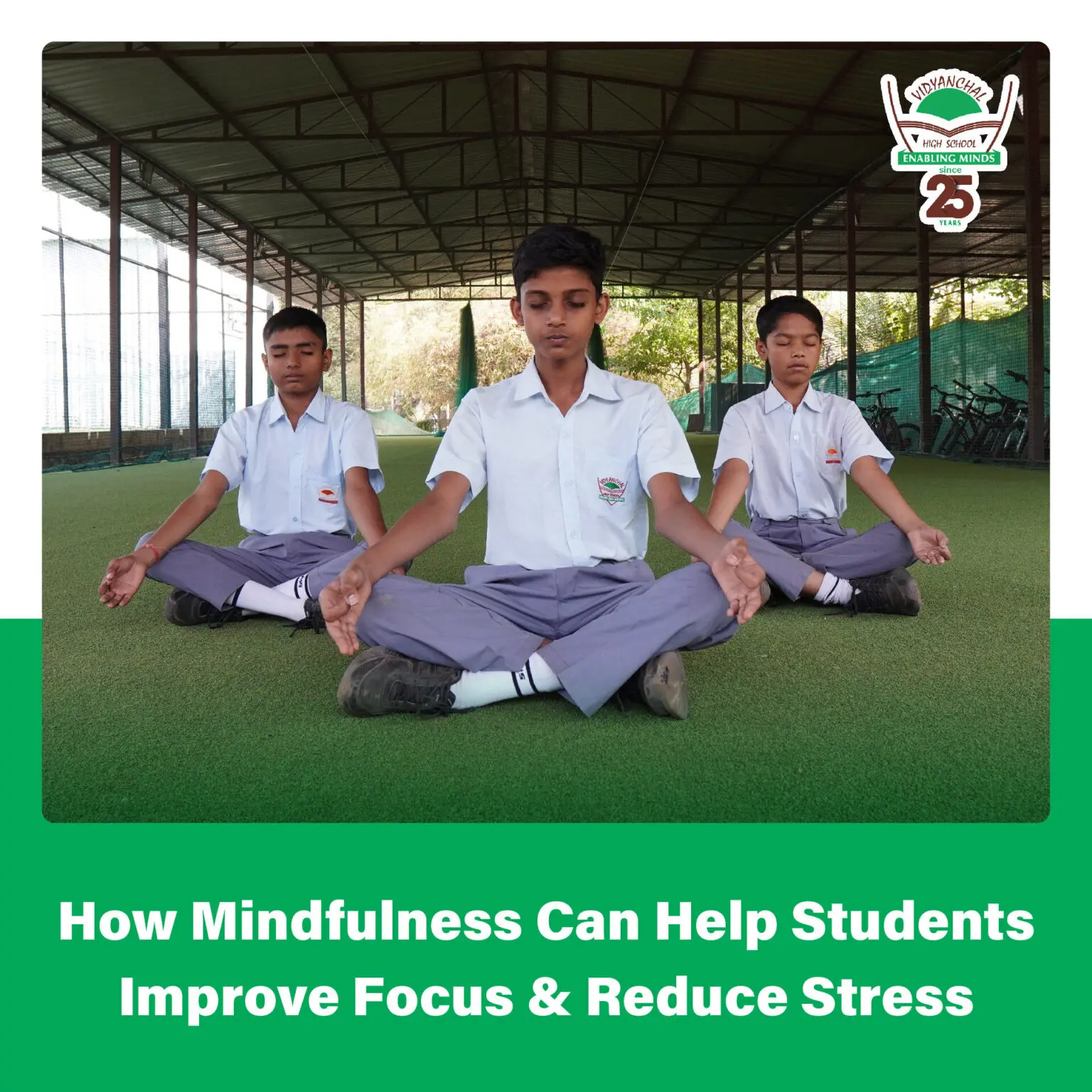In today’s fast-paced academic environment, students- whether in primary school or preparing for competitive exams- face increasing levels of stress and distraction.
Mindfulness, at its core, is the act of being present in the moment without judgment.
With pressure from school, tuition, social media, and parental expectations, maintaining mental well-being and focus has become a significant challenge.
Enter mindfulness- a powerful, science-backed practice that is gaining popularity across Indian schools and households.
For students, this simple but profound approach can improve concentration, reduce anxiety, and enhance emotional regulation.
In this blog, we explore how mindfulness can benefit Indian students, how it can be integrated into daily routines, and why educators and parents should encourage its practice.
Understanding Mindfulness: A Simple Guide
Mindfulness isn’t just about meditation. It’s about being fully aware of the present moment- whether you’re writing in class, doing homework, or playing cricket.
This awareness helps you understand your thoughts and emotions better, making it easier to respond calmly to stressors instead of reacting impulsively.
In practical terms, mindfulness may involve:
- Focusing on your breath for a few minutes
- Paying full attention to a meal without any screens
- Observing your thoughts without judging them
- Listening to a friend without planning your reply
Why Focus & Stress Management Matter for Students
Students in India often have packed schedules. Between school, coaching classes, extra-curricular activities, and screen time, their minds are constantly on overdrive.
According to a 2021 NCERT report, over 80% of Indian students experience academic stress. Add to that the distractions of mobile phones and social media, and it’s clear why focus and emotional balance are more important than ever.
Poor concentration and unmanaged stress can lead to:
- Lower academic performance
- Sleep disturbances
- Irritability and mood swings
- Anxiety and depression
Mindfulness offers a non-invasive, cost-effective, and empowering way to address these issues.
Benefits of Mindfulness for Indian Students
Let’s dive into how mindfulness directly supports students in their academic and personal lives:
1. Improved Concentration
Mindfulness strengthens the brain’s ability to focus on one task at a time. A simple breathing exercise for 5 minutes before studying can clear mental clutter and help the student concentrate better on their books.
Example: A student practicing mindfulness may find it easier to stay focused during a 40-minute math class, reducing silly mistakes and boosting confidence.
2. Reduced Academic Stress
Mindfulness helps students observe their anxiety without being overwhelmed by it. This is especially useful during exam season, when panic can impair performance.
In practice: A mindful approach helps students accept the presence of stress but not let it define their thinking. This leads to calmer test-taking and better decision-making.
3. Better Emotional Regulation
Students often struggle with managing emotions- anger, fear, jealousy. Mindfulness teaches them to pause and respond thoughtfully instead of reacting immediately.
At home or in school: A child may pause before shouting at a sibling or reacting to a classmate’s teasing- just one mindful breath can make the difference.
4. Improved Sleep Quality
Mindfulness reduces mental chatter, helping students fall asleep faster and enjoy deeper rest. This leads to better energy levels and sharper thinking the next day.
Tip: Listening to a 10-minute guided meditation before bed can improve sleep for even young students.
5. Increased Self-Awareness & Confidence
Mindful students become more aware of their strengths, weaknesses, and habits. This self-awareness boosts their self-esteem and helps them develop resilience.
Long term: These skills contribute to not just academic success but also healthier relationships and better life choices.
Indian Schools Adopting Mindfulness
Several progressive Indian schools have already started including mindfulness practices in their curriculum. This includes the following methods:
- Encourages daily reflection time and has introduced breathing and gratitude practices during morning assemblies.
- Offers a “Mindful Monday” program, where students begin the week with a short breathing or meditation session.
- In Pune and Mumbai, many ICSE and CBSE schools are bringing in counselors to conduct weekly mindfulness sessions.
Even NGOs and edtech platforms are providing mindfulness training as part of emotional well-being modules, indicating a shift in how student mental health is approached in India.
Simple Mindfulness Techniques for Students
Mindfulness doesn’t require elaborate routines. Here are some student-friendly techniques that can be easily practiced at home or in school:
1. Five-Minute Breathing Practice
- Sit comfortably and close your eyes.
- Focus on your breath as you inhale and exhale slowly.
- If your mind wanders, gently bring it back to the breath.
Best time: Before starting homework or revision.
2. Mindful Eating
- Eat without watching TV or using your phone.
- Pay attention to the taste, texture, and smell of food.
- Chew slowly and enjoy each bite.
Best time: During lunch break or dinner.
3. Body Scan
- Lie down or sit quietly.
- Slowly bring attention to different parts of your body, from head to toe.
- Notice any sensations without judgment.
Best time: Before bed or after a long school day.
4. Gratitude Journaling
- Write down 3 things you’re grateful for every night.
- This trains the brain to focus on the positive.
Best time: Before going to sleep.
5. Mindful Walking
- Walk slowly in a garden or around your house.
- Notice the feeling of your feet touching the ground.
- Observe sounds, smells, and surroundings.
Best time: Evening walk or school break.
Role of Parents & Teachers in Promoting Mindfulness
In the Indian context, parental and teacher involvement is critical in helping children adopt new habits. Here’s how adults can play a role:
For Parents:
- Practice mindfulness with your child- make it a family habit.
- Limit screen time and encourage mindful mealtimes.
- Praise effort, not just results- this builds self-worth.
For Teachers:
- Begin class with a 2-minute silence or breathing session.
- Encourage reflection journals or mindfulness-based art.
- Be role models- students are more likely to emulate calm teachers.
Challenges in Implementation & How to Overcome Them
While the benefits of mindfulness are clear, integrating it into daily student life can have hurdles:
- Lack of time: Solution – Start with just 3-5 minutes daily.
- Skepticism from parents: Solution – Share research or success stories.
- Inconsistent practice: Solution – Link mindfulness to existing routines (like brushing teeth or meal times).
- Academic focus culture: Solution – Help parents understand that emotional wellness supports better marks, not distracts from them.
Scientific Support: What Research Says
Multiple Indian and international studies have confirmed the benefits of mindfulness for students:
- A 2022 study by AIIMS Delhi found that adolescents who practiced mindfulness had 40% lower stress levels during exam time.
- Harvard Medical School has documented improved cognitive performance and memory retention in students who practiced mindfulness regularly.
- A University of Pune survey among Class 10 students reported that 75% felt calmer and more focused after just 2 weeks of daily mindfulness practice.
Let’s Conclude
Mindfulness isn’t a luxury- it’s a necessity in today’s competitive, overstimulated academic world. For Indian students dealing with exam pressure, peer competition, and digital distractions, mindfulness provides a powerful anchor.
It’s easy to adopt, requires no special tools, and offers lifelong benefits.
Whether it’s a Class 3 student learning to sit still and breathe, or a 17-year-old JEE aspirant managing anxiety before a mock test, mindfulness can help them thrive- not just survive- their academic journey.
As Indian parents and educators, if we start encouraging mindfulness now, we aren’t just improving grades. We’re raising calmer, kinder, and more emotionally intelligent future citizens.
FAQ’s
- What age can children start practicing mindfulness?
Children as young as 5 years can start simple mindfulness practices like breathing and listening games. Teenagers can explore deeper techniques like body scans or journaling. - Does mindfulness really help in improving exam scores?
Yes. Mindfulness improves focus, reduces anxiety, and enhances memory- skills that directly contribute to better academic performance. - How long should students practice mindfulness daily?
Just 5 to 10 minutes a day can bring noticeable benefits. Consistency is more important than duration. - Is mindfulness religious?
No. While it has roots in Buddhist traditions, modern mindfulness is completely secular and focuses on mental health and well-being. - Can schools in India include mindfulness in their curriculum?
Absolutely. Many Indian schools are already doing so through morning routines, wellness classes, and workshops. It complements academic learning beautifully.













